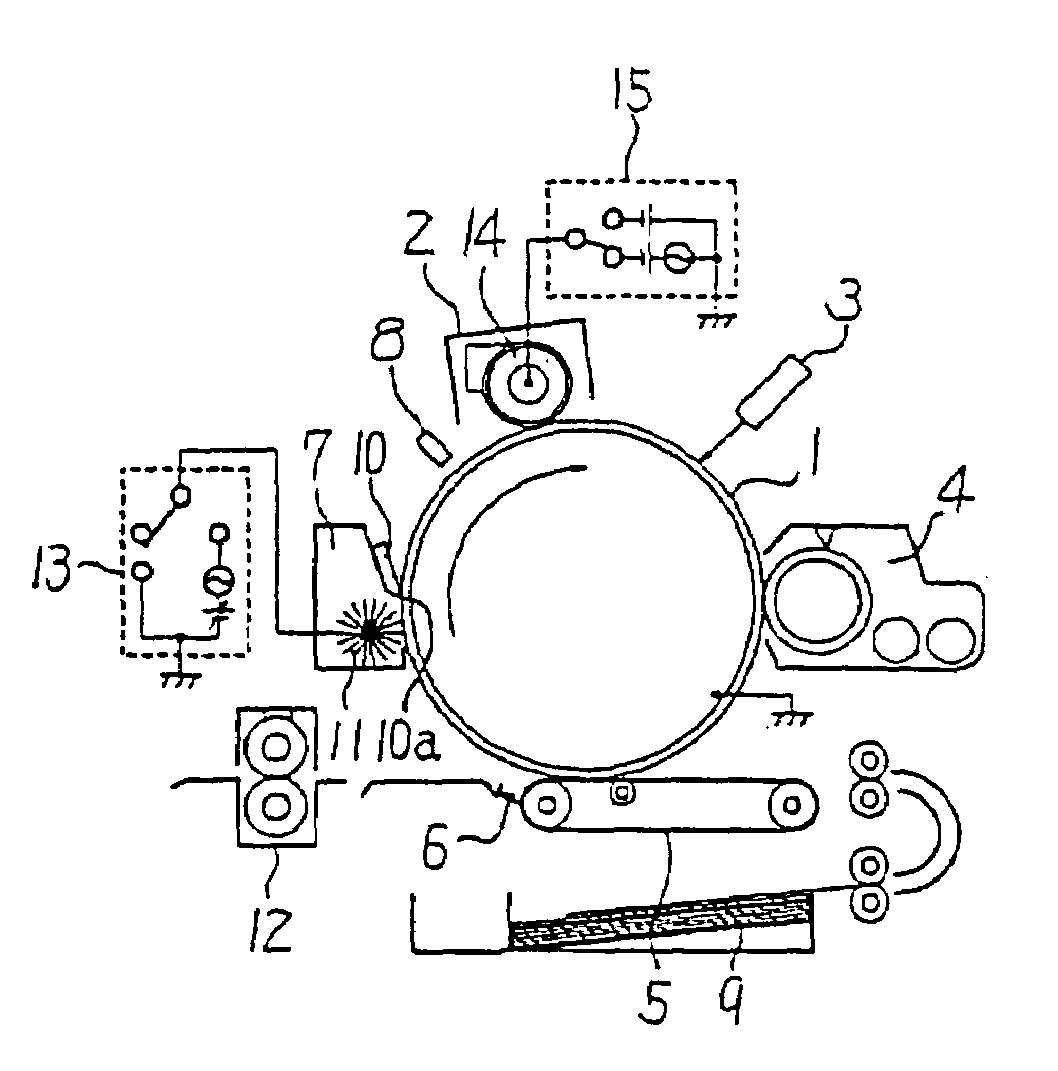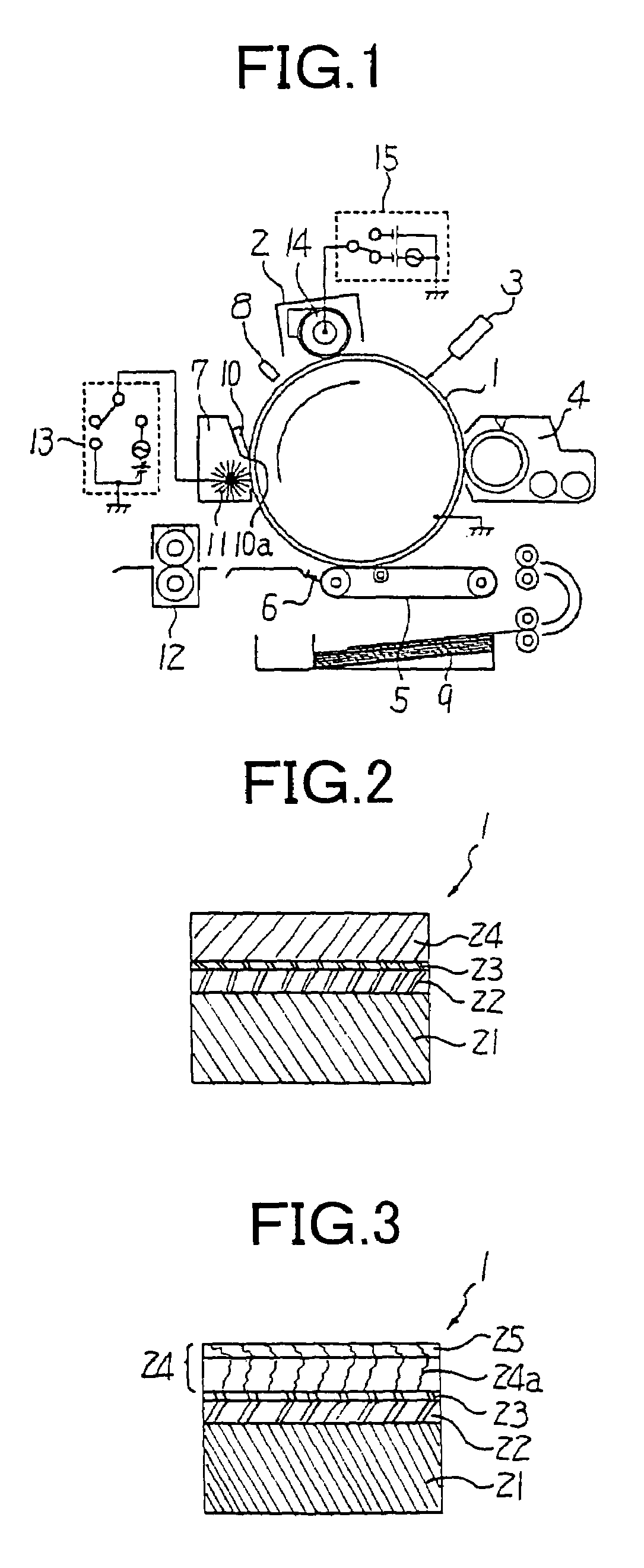However, these photoconductive materials are hazardous and costly.
However, these methods are lack of convenience, and in these days, therefore, a magnetic
brush developing method having such advantages as follows is generally used.
Therefore, charges are difficult to be held identically, and development capability with fidelity to an electrostatic
latent image is low, which makes it difficult to obtain sharp edges.
Further, since the charge of the toner is nonuniform, the toner is not fully transferred to a transferred element, which causes much toner to remain on the photoconductor after transfer process, and also causes cleaning failure when micro toner particles of from about 0.5 μm to about 2 μm are included.
If a contact area becomes wider, toner and
paper dust are forcefully pressed against the photoconductor, which is undesirable.
Thus, both the photoconductor and the cleaning blade are easily and greatly damaged.
However, when the pulverized toner is used, even if the cleaning method in which the cleaning capability is excellent because of the contact in the counter direction is used, there comes up such a problem that cleaning is failed at the first sheet if almost spherical toner with high average
sphericity is used.
Even if the cleaning is perfectly done at the beginning, cleaning failure may suddenly occur in the middle of
copying operation.
Furthermore, a large number of sheets may be copied without realizing the number in an imaging device because it performs bulk copy of data at a high circumferential speed.
Substantially spherical toner particles rush to the blade as if they roll over the photoconductor, and therefore, the toner particles slide into even small spaces to easily cause cleaning failure.
However, if the
frictional resistance increases, frictional heat is produced between the cleaning blade and the photoconductor, which causes the film on the surface of the photoconductor to be melted or toner deposited on the blade to be fused.
Slidability is thereby degraded, and
mechanical pressure balance between the edge of the cleaning blade and the photoconductor is lost.
Furthermore, the cleaning blade cannot come in uniform contact with the photoconductor, micro-vibrations are produced with rotation of the photoconductor, and a space between the cleaning blade and the photoconductor is easily produced.
The stick-slip phenomenon becomes worse with an increase in the frictional resistance of the photoconductor.
Since the frictional force of the blade edge against the photoconductor increases, the photoconductor is easily flawed.
Further, visible scratches occur at a portion against which the blade edge is partially and heavily pushed, that is, the
surface roughness is caused to increase.
The blade edge is susceptible to damage when the cleaning blade slides along a photoconductor especially including an outermost
surface layer that contains a filler of particles with high
hardness such as
alumina or
tin oxide.
This tendency is getting worse with larger particle size of the contained filler.
Furthermore, the photoconductor is hard to be worn, and therefore, the film is easily formed thereon, thus the photoconductor is scraped non-uniformly.
If the deep scratch has been produced, the blade edge is partially twisted or partially applied with pressure, which causes the blade edge to
chip.
If the scratch on the photoconductor and the
chip of the blade edge become larger, cleaning failure of toner more easily occur.
If the frictional resistance of the photoconductor increases, strong pressure is applied to the blade edge, which causes the blade edge to be partially distorted, resulting in being chipped.
If the
chip is large, the space between the photoconductor and the cleaning blade is quite impossible to be shielded even if a higher
contact pressure is applied.
Cleaning failure thereby occurs, and spot-shaped cleaning failure occurs in the initial stage at a portion where the blade largely chips, and the spot-shaped cleaning failure becomes band-shaped.
Furthermore, cleaning failure is thinly and widely spread over a portion of the photoconductor where
surface roughness is high.
Japanese
Patent Application Laid Open (JP-A) No. 2000-162802 discloses that an increase in frictional resistance on the surface of a light receiving member speeds up degradation of a cleaning blade and reduces cleaning capability of residual toner to cause cleaning failure to occur.
This occurs depending on a correlation between pressure force against the photoconductive drum and frictional force with the photoconductive drum, which does not allow normal cleaning.
JP-A No. 2001-265039 discloses that an
organic photoconductor has high frictional resistance with respect to a cleaning blade used to remove residual toner, and therefore, the
organic photoconductor is worn or the surface of the photoconductor is damaged when the cleaning blade cleans the surface thereof.
JP-A No. 2002-258666 discloses that a
frictional coefficient of a photoconductor increases and frictional resistance between cleaning members increases, which causes micro-vibrations or twist of the cleaning member to easily occur on the surface of the cleaning member and cleaning failure of toner to easily occur.
As a result, abrasion of a photoconductive layer is speeded up to shorten the life of the photoconductor.
However, the
frictional coefficient of the photoconductor is kept at a low level because of a large amount of addition of fluororesin, but the quality of a film is friable.
Consequently, some part of the blade edge is easily distorted, and at about the same time, the stick-slip phenomenon tends to easily yet gradually occur.
However, since the linear pressure in this case is twice to four times higher than the ordinary case, which is abnormally high, a
workload to the photoconductor and the cleaning blade become extremely heavy.
Therefore, the photoconductor and the edge of the cleaning blade are damaged, and cleaning failure inevitably occurs early because of
distortion of the blade edge and the stick-slip phenomenon.
It is assumed that Rz<5.0 μm is set because the photoconductor is made to contain a large amount of fluororesin, which causes the
surface roughness of the photoconductor to become inevitably high.
However, the photoconductive layer is worn abnormally, durability of the photoconductor is largely decreased, and the surface roughness of the photoconductor is made higher and higher.
Therefore, the cleaning failure of toner tends to occur early.
If the contact pressure (or linear pressure) of the blade is increased in order to recover the cleaning failure, the photoconductor and the blade edge are getting worse and worse to reach a level where the cleaning failure is impossible to be recovered.
Particularly, if the
surface layer of the photoconductor has the content of fluororesin with which the dynamic
frictional coefficient is kept at such a high level as 2.5, the
distortion of the blade edge and the stick-slip phenomenon surely easily occur, and deposition of the
corona product materials on the photoconductor causes the dynamic frictional coefficient to be increased, and therefore, cleaning failure may occur permanently.
Furthermore, the frictional resistance in the initial stage is low.
As a result, the blade edge is easily distorted and cleaning failure easily occurs caused by micro-vibrations of the blade edge or the stick-slip phenomenon.
In other words, it is difficult to lower the frictional resistance on the surface of the photoconductor, and it is also quite hard to improve the cleaning failure by lowering the frictional resistance with the
lubricant.
Therefore, the frictional resistance on the
surface layer of the photoconductor tends to be increased step by step, which may result in going out of the specified range of frictional resistance during using it.
According to the example in JP-A No. 2001-005359, however, as a result of
image formation by using toner whose average particle size was 7.5 μm, cleaning failure occurred after
image formation of about 23,000 sheets.
However, only the results were described, and no mention was made of the relation between the depth or the width of the blade and the cleaning failure.
The size of the chipped part of the blade edge is an important factor of the cleaning failure, but the cleaning failure is largely affected by the frictional resistance, and therefore, it is also necessary to define the frictional resistance.
Although this method is one of methods effective in measurement of frictional resistance, it has a problem such that the measurement is not stable because the photoconductor is loaded quite heavily.
If the frictional resistance between the photoconductor and the cleaning blade increases, the stick-slip phenomenon tends to occur.
For example, toner produced by the pulverization method or produced by the
polymerization method is hard to be cleaned off, which results in degradation of quality of an image on a copied sheet, that is, background stains appear on the image.
Since an engaging force of the cleaning blade to the photoconductor increases, the surface of the photoconductor is damaged, and 10-point average roughness RzJIS as the surface roughness and its maximum height Rz increase, which causes uneven streaks or the like to occur on an image.
Furthermore, since the engaging force increases, abrasion of the photoconductive layer is speeded up, which causes scratches to occur and the surface roughness to increase.
It is thereby difficult to maintain durability of the photoconductor, and therefore, the life becomes shorter.
The engaging force causes the cleaning blade edge to be worn or easily chipped, streak-like cleaning failure to occur, and overall cleaning failure to easily occur.
Therefore, they are not removed, and a surface frictional resistance rate on the surface layer of the photoconductor lowers, which causes degradation of
image quality such as
image flow to easily occur.
Since the
corona product materials are adhered to the cleaning blade, the blade edge is easily hardened caused by its chemical degradation and easily chipped.
The life of the blade is shortened and cleaning failure occurs, which causes streak patterns to easily occur on an image.
The increased engaging force may cause a drum to make unpleasant so-called squeaking
noise.
As explained above, if the frictional resistance between the photoconductor and the cleaning blade becomes high, various problems occur.
 Login to View More
Login to View More  Login to View More
Login to View More 


